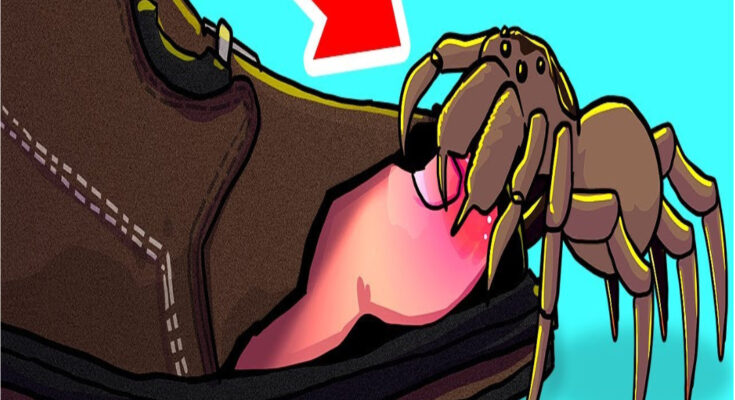Monstrous Creatures You’d Rather Avoid
In the realm of the wild, there are some creatures that send shivers down our spines just at the thought of encountering them. Yet, sometimes fate has other plans, and we find ourselves face to face with these terrifying beings. From spine-chilling beasts that can make your skin crawl to formidable monsters capable of causing severe harm, here’s a glimpse into some of the horrifying animals you’d want to steer clear of at any cost!
The Deathstalker
No one wants to cross paths with a venomous scorpion, and for a good reason. While a scorpion’s sting is painful, some of these creepy critters can inflict far worse damage. Meet the Deathstalker, aptly named as the deadliest scorpion globally. Its sting can prove fatal, especially for the vulnerable like the young, elderly, or weak. But even if you don’t fall into these categories, don’t breathe a sigh of relief just yet! The venom can still trigger a range of unpleasant symptoms, including nausea, vomiting, and diarrhea. Imagine facing a swarm of these lethal creatures! In 2021, the southern province of Aswan in Egypt experienced this nightmare when heavy rains drove hundreds of Deathstalkers from their hiding spots, resulting in 503 people being stung. Thanks to swift action by local authorities, everyone received antivenom treatment, averting a potential catastrophe.
The Black Mamba
Snakes rank high among humanity’s most dreaded creatures, and encountering one unexpectedly can induce sheer panic. Imagine the shock of finding a black mamba, one of the world’s deadliest snakes, coiled up inside your BBQ grill! Known for its potent venom, a black mamba’s bite can be fatal without prompt medical intervention. Fortunately, the homeowner in Durban, South Africa, who stumbled upon this unwelcome guest, emerged unscathed after calling a professional for safe removal. Black mambas are notoriously skittish, capable of lightning-fast strikes at speeds of up to 10 miles per hour, delivering multiple bites in a single attack. Just two drops of their venom spell doom for humans, making evading encounters with these lethal serpents a top priority!
The Beach Explosion
Beachcombing for shells is a cherished pastime during vacations, but stumbling upon a giant, unidentifiable mass is the stuff of nightmares. However, that’s precisely what beachgoers encountered when a sperm whale carcass washed ashore in Western Cape, South Africa, in 2018. Despite being deceased, the decomposing whale continued to bloat with gas, transforming into a grotesque spectacle. As gas builds up within the carcass, it inflates, creating an otherworldly appearance that can evoke a mix of fear and disgust. So, while a beached whale may seem harmless, its decomposing remains can harbor a surprising and unnerving threat.
In the unpredictable wilderness, encounters with terrifying animals are best avoided whenever possible. Whether it’s the deadly sting of a scorpion, the lightning-fast strikes of a black mamba, or the grotesque transformation of a beached whale, steering clear of these chilling creatures is essential for our safety and peace of mind.
When faced with the colossal, fleshy beach ball that is a decomposing whale carcass, one might not anticipate the explosive potential lurking within. As gases accumulate within the bloated mass, the pressure builds until—boom! The carcass erupts, unleashing a forceful blast capable of causing serious harm to anything in its vicinity. And let’s not even mention the putrid odor that accompanies such an event. So, unless you have a peculiar fondness for stinky whale flesh hurtling towards you at alarming speeds, it’s best to maintain a safe distance!
Enter the Tarantula Hawk Wasp—a creature straight out of your worst nightmares. These formidable wasps belong to the spider wasp family, renowned for their ability to incapacitate tarantulas. After paralyzing their arachnid prey with a venomous sting, the Tarantula Hawk Wasp lays an egg inside the immobilized spider. Once hatched, the larva devours the still-living spider from within—a truly gruesome fate. Found across a vast range spanning from the US to Australia, encountering one of these nightmarish insects is a possibility that could send shivers down anyone’s spine.
Take, for instance, the experience of Australian Reddit user Space_Monster, who returned home from work to witness a Tarantula Hawk Wasp dragging off a gigantic huntsman spider—an unsettling sight indeed! Fortunately, these hellish wasps typically shy away from confrontation and prefer flight over fight. However, if provoked, their sting inflicts excruciating pain—so intense that experts recommend lying down and screaming to endure it! And while the agony may last only a few minutes, those moments can feel like an eternity, leaving victims incapacitated and vulnerable.
Now, let’s talk about mosquitoes—the bane of outdoor enthusiasts everywhere. These persistent pests not only irritate with their incessant buzzing but also pose a significant threat to human health. Feeding on their victims’ blood with their long proboscis, mosquitoes inject saliva that prevents blood clotting and numbs the pain of their bites. However, it’s not the bite itself that’s the problem—it’s the potential transmission of life-threatening diseases. Mosquitoes can act as vectors for various pathogens, including the malaria parasite, which claimed over 600,000 lives in 2022 alone.
Consider the harrowing experience of Reddit user Moniq2310, whose outing with her children resulted in a staggering 65 mosquito bites. While she thankfully escaped without contracting any diseases, the thought of these bloodthirsty insects feasting on her skin is enough to send shivers down anyone’s spine. So, while it may not be feasible to fashion Jedi cloaks from mosquito netting, taking precautions against these malicious mozzies is essential for safeguarding one’s well-being.
If you thought the nightmare-inducing creatures we’ve encountered so far were bad, brace yourself for even more spine-chilling horrors!
Let’s start with the Many Legged Horror—the Amazonian giant centipede. While millipedes might seem harmless, their carnivorous cousins, the giant centipedes, are anything but. These aggressive predators, capable of reaching a stomach-churning 12 inches in length, roam the rainforests of South America, preying on creatures ranging from snakes to scorpions. Their venomous bite delivers excruciating pain, swelling, bleeding, and even tissue death in rare cases. So, remember: millipede good, centipede bad!
And then there are the Bear Necessities—unless you’re dealing with an adorable cartoon character, bears are nothing to mess with. One unfortunate vacationer in Yellowstone learned this the hard way when a group of grizzly bears descended upon their campsite, attracted by the scent of an elk carcass nearby. What followed was a harrowing ordeal of survival, with the campers fleeing from the relentless bears for eight agonizing hours. Fortunately, they escaped with their lives, but not without facing the terrifying reality of nature’s apex predators.
Speaking of apex predators, let’s talk about the Colossal Croc—the saltwater crocodile, to be precise. These monstrous reptiles, capable of reaching lengths of 20 feet and weighing over 3,000 pounds, have the strongest bite force of any animal on the planet. With a jaw pressure measuring a staggering 3,700 pounds per square inch, saltwater crocs can crush bones with ease. And their ferocity is not to be underestimated—just ask the unfortunate Japanese soldiers who encountered them during World War II.
Now, onto the Hell Spiders—no, not the stuff of arachnophobes’ nightmares, but rather the camel spider. Despite urban legends portraying them as bloodthirsty monsters capable of leaping six feet in the air and emitting bloodcurdling screams, camel spiders are actually relatively harmless creatures. While their appearance may be terrifying, they pose little threat to humans, aside from delivering a painful bite if provoked. So, rest assured, these desert-dwelling arachnids are more bark than bite.
But if you’re still not convinced that nature is a force to be reckoned with, consider the Deadly Dragons—specifically, the Komodo dragon. These formidable lizards, capable of growing up to 10 feet in length, possess venomous bites that can paralyze prey and cause rapid blood loss. Just ask Maen, the tour guide who found himself face to face with one of these behemoths in his office on Rinca Island. His harrowing encounter serves as a stark reminder of the dangers lurking in the wild.
And let’s not forget the Buzzkills—the northern giant hornets, formerly known as murder hornets, that sent shockwaves through Washington State in 2020. With venom 28 times more potent than that of honeybees, these aggressive insects posed a significant threat to both humans and honeybee populations alike. While efforts to eradicate them were largely successful, their presence served as a sobering reminder of nature’s capacity for destruction.
Finally, we come to the Terrifying Tapeworms—a reminder that sometimes the most horrifying creatures are the ones we can’t see. These insidious parasites, contracted through the consumption of undercooked meat, can wreak havoc on the human body, with symptoms ranging from headaches to seizures. Just ask the unfortunate individual who discovered a tapeworm wriggling around in their brain—a chilling reminder of the dangers lurking within.
So, whether it’s giant centipedes, grizzly bears, saltwater crocs, camel spiders, Komodo dragons, giant hornets, or tapeworms, one thing’s for sure: nature is full of horrors that demand our respect and caution. So, the next time you venture into the great outdoors, remember to tread carefully—and maybe bring along some bear spray, just in case.



